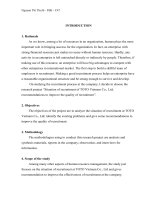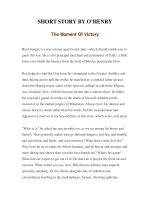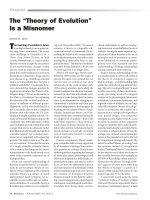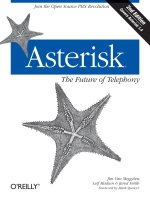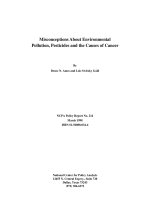- Trang chủ >>
- Khoa Học Tự Nhiên >>
- Vật lý
The Physics of Communiction doc
Bạn đang xem bản rút gọn của tài liệu. Xem và tải ngay bản đầy đủ của tài liệu tại đây (34.56 MB, 688 trang )
c
Ecg
The
Physics
of
C o m m u n i c t i o n
XXII
SOLVAY
CONFERENCE ON PHYSICS
Delphi
and
Lamia,
Greece,
24-29
November
200
1
1.3. LEUCHS M. LUKIN RY. CHIAO
S.
METENS
L.
REICHL P. SIAFARIKAS L. STODOLSKY
A
KARLSSON K. GUSTAFSON
S.KIM
V. KADYSHEVSKY G. ORDONEZ I. ZISIS G. DIMAKIS
A
DIMAKIS
G.
TSAKLIDIS R. PASSANTE
S.
DOLEV
A
ELITZUR C. KARANIKAS
S.
PASCAZIO D.
XOURIS
M. COURBAGE E. YAREVSKY Yu. MELNIKOV
A
SISSAKL4N G. ZENG
E.
KARPOV V. LETOKHOV
L.
WANG W.S. SCHLEICH
J:M.
RAIMOND
A
STEINBERG
0.
NIMTZ E.
POUIK
N.
SOURLAS
T. PETROSKY C.
DASKALOYANNIS
M. FLORATOS
SI
SI
T.
HIDA
V.V. BELOKUROV
L.
VAIDMAN
Vi
KOCHAROVSKY
0.
KOCHAROVSKAYA M. GADELLA
A
BOHM G. PRONKO
L.
ACCARDI V. GURZADYAN
S.
LLOYD G. HEGERFELDT P. STAMP P. ZOLLER
Front
row:
A
ZEILINGER
B. MISRA Y. NE'MAN
E.C.G. SUDARSHAN
I.
PRIGOGINE
J.
SOLVAY H. WALTHER H.J. KIMBLE M. RAJZEN
N.
THEOFANOUS I. ANTONIOU T. DURT
om
U
ic
io
Proceedings
of
the
XXll
Solvay Conference on Physics
Delphi Lamia, Greece
24
-
29
November
2001
edited
by
I
Antoniou
(International Solvay Institutes for Physics and Chemistry, Belgium
&
Aristotle University
of
Thessaloniki, Greece)
V
A Sadovnichy
(Lomonosov Moscow State University, Russia)
H Walther
(University
of
Munich, Germany
&
Max-Planck-Institute for Quantum
Opbcs, Germany)
orld Scientific
Jersey
London
Singapore Hong Kong
The
C
m
n
at
n
Published by
World Scientific Publishing Co. Pte. Ltd.
5 Toh Tuck Link, Singapore 596224
USA
ofice:
Suite 202, 1060 Main Street, River Edge,
NJ
07661
CJK
office:
57
Shelton Street, Covent Garden, London WC2H
9HE
British Library Cataloguing-in-Publication Data
A
catalogue record for this book is available
from
the British Library
THE PHYSICS
OF
COMMUNICATION
Proceedings
of
the
XXII
Solvay Conference on Physics
Copyright
0
2003 by World Scientific Publishing Co. Re. Ltd.
All
rights reserved. This book, or parts thereof; may not be reproduced in any form or by any means,
electronic or mechanical, includingphotocopying, recording or any information storage and retrieval
system now known or to be invented, without written permission from the Publisher.
For photocopying
of
material in this volume, please pay a copying fee through the Copyright
Clearance Center, Inc., 222 Rosewood Drive, Danvers,
MA
01923,
USA.
In this case permission to
photocopy is not required from the publisher.
ISBN 981-238-449-9
Printed in Singapore
by
World Scientific Printers
(S)
Pte Ltd
CONTRIBUTORS TO
THE
PROCEEDmGS
OF
THE
XXII
SOLVAY
CONFERENCE ON PHYSICS
L.
Accardi
University of Rome
Centro V. Volterra
Via di Tor Vergata
1-00133 Rome, Italy
I. Antoniou
Dept. of Mathematics
Aristoteles University
of
Thessaloniki
54006, Thessaloniki, Greece
and
International Solvay Institutes for Physics and Chemistry
ULB, Campus Plaine
-
CP 23
1
Boulevard du Triomphe
1050, Brussels, Belgium
V.V. Belokurov
Institute for Mathematical Study of Complex Systems
Lomonosov Moscow State University
Vorobievyi
Gori
Moscow 119899, Russia
A. Bohm
University
of
Texas at Austin
Department of Physics
Center for Particle Theory, RLM 9.324A
Austin, Texas 78712-1081, USA
G.
Casati
Dean
University of Insubria of Como
Via Valleggio
11
22100 Como, Italy
K.
Chatzisawas
Department of Physics
Aristotle University of Thessaloniki
54006 Thessaloniki, Greece
R. Chiao
Department of Physics
University of California at Berkeley
366 Le Conte
Hall
#
7300
Berkeley, CA 94720-7300, USA
V
vi
I. Cirac
Max-Planck Institute her Quantenoptik
Hans-Kopfermann Str.
1
85748 Garching, Germany
C. Daskaloyannis
Department of Physics
Aristotle University
of
Thessaloniki
54006 Thessaloniki, Greece
S.
Dolev
The Program for History and the Philosophy of the Sciences
Unit of Interdisciplinary studies
Bar-Ilan University
52900
Ramat-Gan, Israel
A.
Ekert
Department of Physics
University of Oxford
Clarendon Laboratory
Parks Road
Oxford
OX1
3PU, U.K
A.
Elitzur
Weizmann Institute
of
Science
PO
Box
26
Rehovot 76
100,
Israel
D.
Ellinas
Department of Sciences
Section of Mathematics
Technical University of Crete
GR-73 100 Chania Crete, Greece
M. Gadella
Departamento de Fisica Teorica
Facultad de Ciencias
University of Valladolid
Real de Burgos, s.n.
4701
1
Valladolid, Spain
V.G.
Gurzadyan
ICRA, Dipartimento di Fisica
Universita di Roma "La Sapienza"
00185 Rome, Italy
and Yerevan Physics Institute
375036 Yerevan
Armenia
vii
K.
Gustafson
Department
of
Mathematics
University
of
Colorado
Campus Box 395
Boulder, Colorado 80309-0395, USA
G.
Hegedeldt
Institut fiir Theoretische Physik
University
of
Gottingen
Bunsenstrasse 9
D-37073 Gottingen, Germany
K. Imafuku
Centro Vito Volterra
Facolta di Economia
Universita di Roma "Tor Vergata"
Via Columbia 2
00133 Roma, Italy
L.
Jacak
Institute
of
Physics
Technical University of Wroclaw
Wybrzeze Wyspianskiego 27
50-370 Wroclaw, Poland
I.
Kanter
Department
of
Physics
Bar-Ilan University
Ramat Gan 52900, Israel
A. Karlsson
Department
of
Microelectronics and Information Technology
Laboratory
of
Quantum Electronics and Quantum Optics
Royal Institute
of
Technology (KTH)
Electrum 229
S-164 40 Kista, Sweden
S.
Kim
University
of
Texas at Austin
Department
of
Physics
Austin, Texas 78712, USA
H.
J.
Kimble
California Institute
of
Technology, 12-33
Quantum Optics, Laboratory
of
Physics
Pasadena, CA
91
125, USA
0.
Kocharovskaya
Department
of
Physics
Mailstop 4242
viii
Texas A&M University
College Station, TX
77843-4242,
USA
Vi. Kocharovsky
Department
of
Physics
Texas A&M University
College Station, TX
77843-4242,
USA
V.
S.
Letokhov
Institute of Spectroscopy
of
Russian Academy
of
Sciences
Troitsk, Moscow Regon
142092
Russian Federation
G. Leuchs
University Erlangen-Nurnberg
Staudtstrasse
7
I
B2
91058
Erlangen, Germany
S.
Lloyd
Dept. of Mechanical Engineering
Massachusetts Institute
of
Technology
77
Massachusetts Avenue
Cambridge, MA
02139-4307,
USA
M. Lukin
Physics Department
Lyman Laboratory
Harvard University
17
Oxford Street
Cambridge,
MA
02138,
USA
G. Metakides
Director
IST
-
DG
INFSO
European Commission
Avenue de Beaulieu
29
-
7/10
B-
1
160
Brussels, Belgium
S.
Metens
Laboratoire de Physique Theorique de la Matiere Condensee
Universite de Paris
7
Case Postale
7020
2,
Place Jussieu
F-7523
1
Park Cedex
05,
France
B.
Misra
International Solvay Institutes for Physics and Chemistry
ULB, Campus Plaine
-
CP
23
1
Boulevard du Triomphe
1050
Brussels, Belgium
ix
K.
Moelmer
University of Aarhus
Institute for Physics and Astronomy
Building 520
Ny Munkegade
DK-8000 Aarhus, Denmark
Y.
Ne’eman
Professor Emeritus of Physics, TAU
Tel-Aviv University
Ramat Aviv
Tel Aviv 69978, Israel
G. Nimtz
University of Cologne
Institute of Physics
Zulpicher strasse 77
D-50937 Cologne, Germany
G. Ordonez
Center for Studies in Statistical Mechanics and Complex Systems,
RLM
7.220
University of Texas at Austin
Austin, Texas 78712, USA
Ch. Panos
Department of Theoretical Physics
Aristoteles University of Thessaloniki
Thessaloniki 54006, Greece
S.
Pascazio
Department of Physics
University of Bari
Via Amendola 173
1-70126
Bari,
Italy
R. Passante
IAIF-CNR
Via Ugo La Malfa 153
1-90146 Palermo, Italy
T. Petrosky
Center for Studies
in
Statistical Mechanics and Complex Systems, RLM 7.220
University of Texas at Austin
Austin, Texas 78712, USA
E. Polzik
University of Aarhus
Institute of Physics and Astronomy
Building 520
Ny Munkegade
X
DK-8000 Aarhus, Denmark
I.
Prigogine
International Solvay Institutes
for
Physics and Chemistry
ULB, Campus Plaine
-
CP 23
1
Boulevard du Triomphe
1050, Brussels, Belgium
3 M.
Raimond
Laboratoire Kastler Brossel
Departement de Physique
Ecole Normale Superieure
24, rue Lhomond
75005 Paris Cedex 05, France
M.
Raizen
Department
of
Physics
The University
of
Texas at Austin
Austin, Texas 78712, USA
L.
Reid
Center
for
Studies in Statistical Mechanics and Complex Systems, RLM 7.220
University
of
Texas at Austin
Austin, Texas 78712, USA
W.
P. Schleich
Abt. her Quantenphysik
Universitat Ulm
D-89069 Ulm, Germany
N.
Sourlas
Departement de Physique
Ecole Normale Superieure
24, rue Lhomond
7523 1 Paris Cedex 05, France
Prof P. Stamp
Canadian Institute
for
Advanced Research and Physics Dept
University
of
British Columbia
6224 Agricultural Rd.
Vancouver, B.C., Canada V6T 121
A. Steinberg
Department
of
Physics
University
of
Toronto
60
George Street
Toronto, Ontario, Canada M5S 1A7
L.
Stodolsky
Werner-Heisenberg-Institut
xi
Fohringer Ring 6
80805 Munich, Germany
E.C.G. Sudarshan
Department
of
Physics, RLM 9.328A
University
of
Texas at Austin
Austin, Texas 78712, USA
L.
Vaidman
Physics and Astronomy Faculty
Tel Aviv University
PO Box 39040
Tel Aviv
69978.
Israel
H. Walther
Sektion Physik
University
of
Munich
Am
Coulombwall
1
D-85748 Garching, Germany
L.
Wang
NEC Research Institute Inc.
4 Independence Way
Princeton, New Jersey 08540, USA
A.
Zeilinger
Institut
fbr
Experimentdphysik
University
of
Vienna
Boltzmanngasse 5
Wien 1090, Austria
G. Zeng
Theoretische Quantendynamic
Fakultat
fiir
Physik
Universitat Freiburg
H-Herder-Strasse
3
D-79104 Freiburg, Germany
P. Zoller
University
of
Innsbruck
Institut 6ir Theoretische Physik
Technikerstrasse 25
A-6020 Innsbruck, Austria
ADMINISTRATIVE COUNCJL
OF THE
INTERNATIONAL
INSTITUTES
FOR
PHYSICS
AND
CHEMISTRY,
F0UNDEDBYE.SOLVAYA.S.B.L.
J.
Solvay
F.
Bingen
I.
Prigogine
I. Antoniou
F.
Lambert
A.
Bellemans
M.
Henneaux
D
.
Janssen
A.
Jaumotte
R. Lefever
G.
Nicolis
J M.
Piret
I. Veretenicoff
N.
Schamp
President
of
the Administrative Board
Vice-president of the Administrative Board
Director
of
the Solvay Institutes
Deputy Director
of
the Solvay Institutes
Secretary
of
the Administrative Board
Secretary
of
the Scientific Committee
of
Chemistry
Secretary
of
the Scientific Committee
of
Physics
Consultant for the Administrative Board
xii
SCIENTIFIC COMMITTEE
OF
PHYSICS
OF
THE
INTERNATIONAL INSTITUTES
FOR
PENSICS AND CHEMISTRY,
FOUNDED BY E. SOLVAY A.S.B.L.
A.ABRAGAM
Professeur Honoraire au College de France
Rue d’Ulm,
3
75005
Paris, France
P.
W.
ANDERSON
Dept.
of
Physics
Princeton University
Princeton, NJ
0851 1,
USA
F. T. ARECCHI
Directeur
Istituto Nazionale de Ottica Applicata
Large
E.
Fermi
6
1-50125
Florence, Italy
A. BOHM
University of Texas at Austin
Department
of
Physics
Center for Particle Theory,
RLM
9.324A
Austin, Texas
78712-1081,
USA
C. COHEN-TANNOUDJI
Laboratoire Kastler Brossel, Department de Physique
Ecole Normale Superieure
24,
rue Lhomond
7523 1
Paris Cedex
05,
France
L.
FADDEEV
Steklov Mathematical Institute
Fontanka
27
St. Petersburg
191011,
Russia
M.
HENNEAUX
Departement de Physique
Universite Libre de Bruxelles, CP
23 1
Bd. du Triomphe
1050
Bruxelles, Belgium
I.
M. KHALATNIKOFF
Russian Academy of Sciences
Landau Institute of Theoretical Physics
2
UI
Kozygina, V
334
Moscow
117 940,
Russia
xiii
xiv
Y.
NE’EMAN
Sackler Institute
for
Advanced Study
Tel-Aviv University
Rarnat Avk
Tel Aviv 69978, Israel
R.Z. SAGDEEV
East West Place Science Center
(Room 3373)
University
of
Maryland
College Park,
h4D
20742, USA
G. SETTI
European Southern Laboraory
2,
Karl-Schwarzschild-Strasse
D-8046 Garching-bei-Miinchen, Germany
E.C.G. SUDARSHAN
Department
of
Physics,
RLM
9.328A
University
of
Texas at Austin
Austin,
Texas 78712, USA
G. t’HOOFT
Spinoza Institute
Utrecht University
NL
3508 TD Utrecht, Netherlands
PO
BOX
80-195
S.C TONWAR
Tata Institute
for
Fundamental Research
Homi
Bhabba Marg, Navy Nagar
Colaba, Bombay 400
005,
India
H.
WAL,THER
Max-Planck-Institute
fiir
Quantenoptik
D-8046
Garching-bei-Miinchen, Germany
E.
Venizelos
J.
Solvay
I.
Prigogine
G.
Mtsopoulos
T. Patrikios
V. Exarchos
S.
Alachiotis
G.
Babiniotis
P. Lazaridis
T. Lekkas
C. Massalas
HONORARY COMMITTEE
Minister of Culture, Hellenic Republic
President, International Solvay Institutes for Physics and Chemistry
Director, International Solvay Institutes for Physics and Chemistry
President, Academy of Athens
President, Society for the Hellenic Cultural Inheritance
General Secretary for Central
Greece
Rector, University of Patras
Rector, National and Kapodistrian University
of
Athens
Rector, University of Thessalia
Rector, University
of
the Aegean
Rector, University
of
Ioannina
M. Papadopoulos Rector, Aristoteles University of Thessaloniki
K.
Simopoulos
T. Xanthopoulos Rector, National and Technical University of Athens
Rector, Demokritus University of Thrace
xv
HELLENIC SCIENTIFIC COMMITTEE
Prof.
I.
Antonopoulos Vice Rector
Aristotle University of Thessaloniki
Prof. K. Daskaloyannis Department of Physics
Aristotle university of Thessaloniki
Prof. M. Floratos
Prof. C.
Karanikas
Prof.
D.
Krawaritis
Prof. N. Theofanous
Prof.
Th.
Tomaras
Demokritos Research Center and Department of Physics
University of Athens
Department of Mathematics
Aristotle University of Thessaloniki
ChairItlan
Department of Applied Mathematics and Physics
National Technical University of Athens
Department of Wormatics
University of Athens
Department
of
Physics
University of Crete
LOCAL ORGANISING COMMITTEE
Mr. V. Exarchos
Mr. T. Bellos
Mrs. M. Karayanni
Mr.
G. Kotmnias
Prof R. Kotronia
Mr.
I.
Zisis
Prof. K. Anastasiou
General Secretary of Central Greece
Region
Prefect of Fthiotida
Prefecture of
Fthiotida
Mayor of Lamia
Lamia Town
Hall
Solon
Cultural Center
President
Technological Education Institute of Lamia
Prof.
Th.
Kontogeorgos Technological Education Institute of Lamia
xvi
THE
SOLVAY
CONFERENCES
ON
PHYSICS
The Solvay conferences started in 1911.
The first conference on radiation
theory and the quanta was held in Brussels.
This
was a new type of conference and it
became the tradition of the Solvay conference; the participants are informed experts in
a given field and meet to discuss one or a few mutually related problems
of
fundamental importance and seek to define the steps for the solution.
The Solvay conferences in physics have made substantial contributions to the
development of modem physics in the 20"' century.
1. (191 1) "Radiation theory and the quanta"
2. (1913) "The Structure of the matter"
3. (1921) "Atoms and electrons"
4. (1924) "Electric Conductivity of Metals"
5.
(1927) "Electrons and photons"
6. (1930) "Magnetism"
7. (1933) "Structure and properties of the atomic nuclei"
8. (1948) "Elementary particles"
9. (195 1) "Solid state"
10. (1954) "Electrons in metals"
11. (1958) "The structure and evolution of the Universe"
12. (1961) "The quantum theory offields"
13. (1964) "The structure and evolution of galaxies"
14. (1967) "Fundamental problems
in
elementary particle physics"
15. (1970) "Symmetry properties of nuclei"
16. (1973) "Astrophysics and gravitation"
17. (1978) "Order and fluctuations in equilibrium and non-equilibrium statistical
mechanics"
18. (1982)
"High energy physics. What
are the possibilities for extending our
understanding of elementary particles and their interactions to much greater
energies?"
19. (1987) "Surface science"
20. (1991) "Quantum Optics"
2 1.
(
1998) "Dynamical systems and irreversibility"
22. (2001) "The Physics of Communication"
For more information, visit the website of the Solvay Institutes
http:Nsolvayins.ulb.ac.be
xvii
This page intentionally left blank
PREFACE
This volume includes papers presented at the
XXII
Solvay Conference on Physics, which took
place from the
24
to
29
November
2001
in the European Culture Centre of Delphi. The
Castle of Lamia hosted the events of the last day.
The Physics of Communication was the selected theme of the conference. The
5
sessions
reflected present challenging issues, namely Decoherence and Irreversibility, Non-locality and
Superluminosity, Photonics, Quantum Information and Communication, Quantum
Computation. The lively discussions, which followed the reports, have been recorded and are
included after the presentations
The realisation of the
XXII
Solvay Conference was possible thanks to the complete spiritual
and financial support of the Ministry of Culture of the Hellenic Republic and the personal
interest of the Minister, Professor Evangellos Venizelos.
The excellent organisation is due to the professional and personal care of the personnel and
the Director of the European Cultural Centre, Prof. V. Karasmanis, in collaboration with the
administrative support and active interest of Dr.
A.
Soulogianni, Director
of
Educational
Affairs of the Ministry of Culture.
The key catalyst for the organisation and success of the Conference was Mr. K. Gouvalas,
Director of the Minister’s
office.
The idea to organise the
XXII
Solvay Conference in Central Greece came spontaneously
during a friendly meeting
of
one of
us
(Ioannis Antoniou) with
Mr.
T. Bellos, prefect of
Fthiotis,
Mr.
G.
Kotronias, Mayor of Lamia, Prof.
K.
Anastasiou, President of the
Technological Education Institute of Lamia and Mr.
Y.
Zisis, representative
of
“Solon”
Cultural Foundation. Afterwards, they honoured their commitment with active interest,
continuous support and personal involvement.
Thanks to the initiative and support of the Ministry of Culture, the internationally recognised
pianist, Vinia Tsopela, Professor of the University of Macedonia, performed Hadjidakis and
Chopin at the opening, thus creating a marvellous atmosphere.
V. Dimitropoulos, Professor of Mathematics, and his group of amateur dancers performed
traditional Hellenic dances in an original way during the banquet.
Dr. E. Yarevsky and Dr.
S.
Metens kindly helped in the scientific aspects of the organisation
The heavy organisational details were arranged thanks to the coordinated effort of several
people. In particular we mention
Mrs.
Anne De Naeyer, from the Solvay Institutes,
Mrs.
A.
Gotsi from the European Cultural Center,
Mr.
M. Kostakis and E. Tsekoura from the Ministry
of Culture,
Mrs.
M. Karayanni from the Prefecture of Fthiotis,
Prof
R. Kotronia, Director of
the office of the Mayor of Lamia,
Mrs.
I.
Moutsopoulou-Zisi, Mr.
A.
Belesis, Mr.
I.
Paraskevolakos,
Mr.
N. Theodorakis,
Mr.
P. Katsoulakos, Mr. D. Sarinakis and
Mr.
G.
Mavrouleas from Solon Cultural Foundation.
The conference could be observed in real time, via the Internet, thanks to the kind sponsoring
of the Hellenic Telecommunications Organisations (OTE and COSMOTE).
Mr.
A.
Dimakis,
xix
xx
Mr.
G. Dimakis and
Mr.
Y.
Zisis coordinated the teleconference effort. During the
conference, about
2000
visits have been registered.
The T.V. broadcasting and interviews were arranged by
Mr.
Y.
Zisis (STAR Lamia Channel)
and by
Mr.
P.
Savidis (National Channel
ET
3).
The presentations in ET3 have been repeated
more than
10
times during the following year at the request of the public.
h4r.
Y.
Zisis, in
addition to overall support, arranged also the press releases and the publicity. About
10
articles were devoted to the conference. The whole publicity effort was coordinated by
h4r.
A.
Dimakis.
For the security
of
the conference, the Prefectural Police of Fokis and Fthiotis took special
care. The Prefectural Hospitals of Fokis and Fthiotis were
also
especially available on a
24
hours basis. The General Secretary of Central Greece,
Mr.
V.
Exarchos kindly arranged for
that. We were very happy to know about these measures and
most
happy not to use them.
Finally, we gratellly acknowledge the enthusiastic support of
Mr.
J.
Solvay and Prof
1.
Prigogine.
I.
Antoniou
V.
A.
Sadovnichy
H.
Walther
PROLOGUE
by Minister
E.
Venizelos
It is with special pleasure to see that this edition completes the effort to
prepare and realise the
XXII
Solvay Conference on Physics, which has been hosted by
the Ministry
of
Culture in the European Cultural Centre of Delphi with great success.
We had the opportunity to attend leading scientists presenting and discussing
the new impressive possibilities in Physics, which are expected to re-shape
communication in the years to come.
I
was especially pleased to welcome Ilya
Prigogine, Nobel Laureate, key founder
of
chaos theory and
Mr.
Jacques Solvay,
President of the Solvay Institutes. It is well
known
that the Solvay conferences
shaped the path of physics in the
20"
century, as
so
many mythical personalities like
Albert Einstein, Max Planck, Marie Curie, Niels
Bohr,
Werner Heisenberg, actively
participated in these conferences.
It
is
a
common secret that the Solvay conferences
have also served as a platform for the Nobel Prizes.
Progress in physics and chemistry in the
20"
century has been intertwined
during the last ninety years with the activities of the Solvay Institutes. The
XXII
Solvay Conference on Physics marks the passage and continuation of the Solvay
Conferences into the
215'
century. This edition will be one more stepping stone in the
history of science. In this sense, the Ministry of Culture of the Hellenic Republic is
specially satisfied to contribute to this important scientific progress, by organising and
supporting the
XXII
Solvay Conference on Physics.
xxi
CONSEIL
DE
PHYSIQUE
SOLVAY
BRUXELLES
1911
X
x.
OPENING ADDRESS BY
J.
SOLVAY
Ladies and Gentleman,
It is a great pleasure and honour to open the
22“d
Solvay Conference on Physics. It
is
a
special day for me. From October
30
till November
3,
191 1, the first Solvay conference
took place
in
Brussels nearly 90 years ago. The theme of the fust conference was
Radiation and Quanta. This is now the first Solvay conference in the
XXI
century.
I
am
also very pleased that this conference takes place in Greece. Our presence here
is
a
tribute to the role of Greek science and philosophy in the Western worldview.
Since 90 years, there has been an enormous change in science, as well as in the interaction
between science and society. For a long time, science appeared as a highly specialized
field, an elitistic occupation. For Einstein, scientists were people who wanted to escape
the vicissitudes of every day life. Today science is permeating all our life, especially fields
such
as
communication and molecular biology.
My great grand father, Ernest Solvay was confident that sciences will lead to an
improvement
of
the human condition. He was a man of multiple interests, equally
attracted by Physics, Chemistry, Physiology and Sociology. The possible role of science
in the present society is a conflictual subject.
Is
this really an occasion for the
improvement of human condition or is science bringing
us
closer to apocalypse? We can
only guess what the future may be. It is still likely that science, communication especially,
will permit
us
to reach a more multicultural and less conflicting society.
The Solvay conferences have been, in the past, exceptionally successful. Heisenberg has
written: “The Solvay Meetings have stood as an example
of
how much well-planned and
well-organised conferences
can
contribute to the progress
of
science”.
I
am sure that this
conference will be as successful as the preceding ones. It was often said that the people
who came together at the Solvay conferences went then to Stockholm to receive the
Nobel Prize. This is somewhat exaggerated, but there is some truth to it.
Here is the photograph of the first Solvay meeting, where we see
Mrs
Curie, Poincare,
Einstein, and many other famous people, who received indeed the Nobel Prize.
Thank
you.
xxiii
OPENWG
REMARKS
BY
I.
PRIGOGEVE
Dear colleagues, authorities, friends,
I
first want to thank the Greek authorities for their magnificent hospitality we receive
here.
I
specially want to thank my colleague and &end, Professor Ioannis Antoniou, who
has organised the conference.
I
want also to thank the local committee, which has made
the arrangements and all participants, who will,
I
am
convinced, make this conference a
success.
As
Mr.
Solvay mentioned, the
first
meeting was exactly ninety years
ago
in Brussels. The
subject of this first conference was “electrons and photons”.
In a sense, the present
conference continues the problems studied in the first conference as it deals largely again
with interactions, with the matter,
as
light.
In
the
20“
century, we have attended the birth
of
a new Physics. The progress realized is amazing. There was a feedback between
progress in science and the Solvay conferences. Thanks to this progress, we had very
interesting Solvay conferences and conversely the Solvay conferences contributed
to
the
development
of
new results in science. The progress has been such that many physicists
say “We are now at the end of the golden age, we are at the end of creative Physics. How
could we imagine something else of comparable importance after the achievement of the
20fi
century?” The last frontiers would be the high-energy physics, cosmology or the
brain.
I
have heard this suggested by a few very
famous
physicists.
I
personally don’t
believe it.
I
think there is a kind of autocatalytic character in the evolution of science.
More we discover and more we are likely to discover.
So
much has been discovered in
the
20*
century. This is for me an indication that we shall all make, in the future again,
new fundamental discoveries.
Take the problem of communication. How many aspects
have we missed? The first aspect, which
I
want to emphasize, is the relation between
communication and irreversibility. It is clear that the situation, after we receive a
message,
is
different from the one which was existing before the communication was
established. We obtain new information and this new information will contribute to the
decision we take for the future. Let me emphasize that, in my view, the
flow
of time, the
arrow
of
time is not due to the fact that the communication is first prepared and then
received, like we prepare breakfast and then we eat it.
On
the contrary, it is because there
is an arrow of time in the universe that we first prepare our breakfast, to eat it later. In
xxiv
